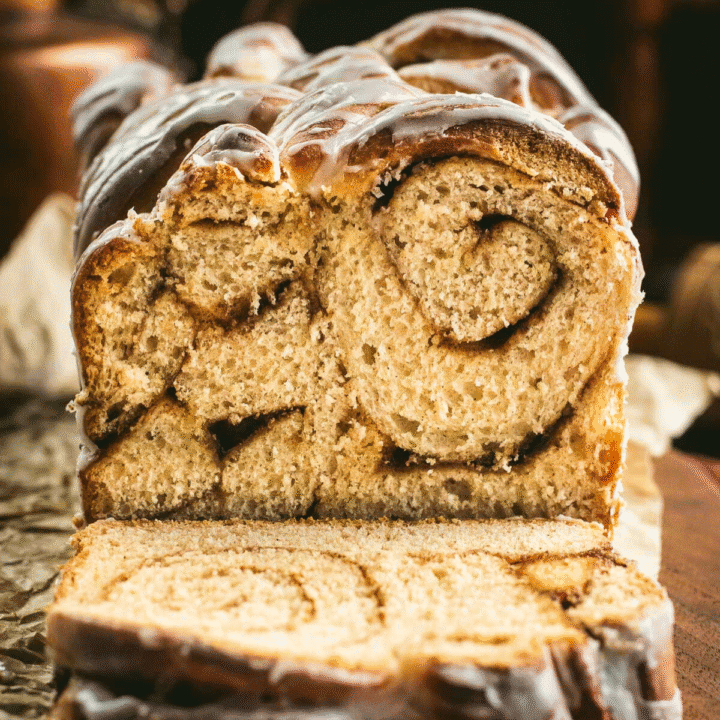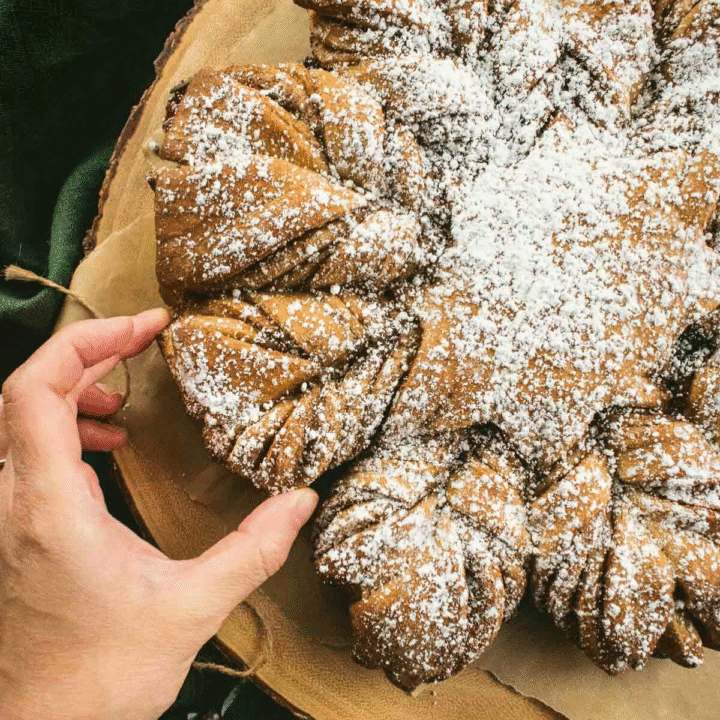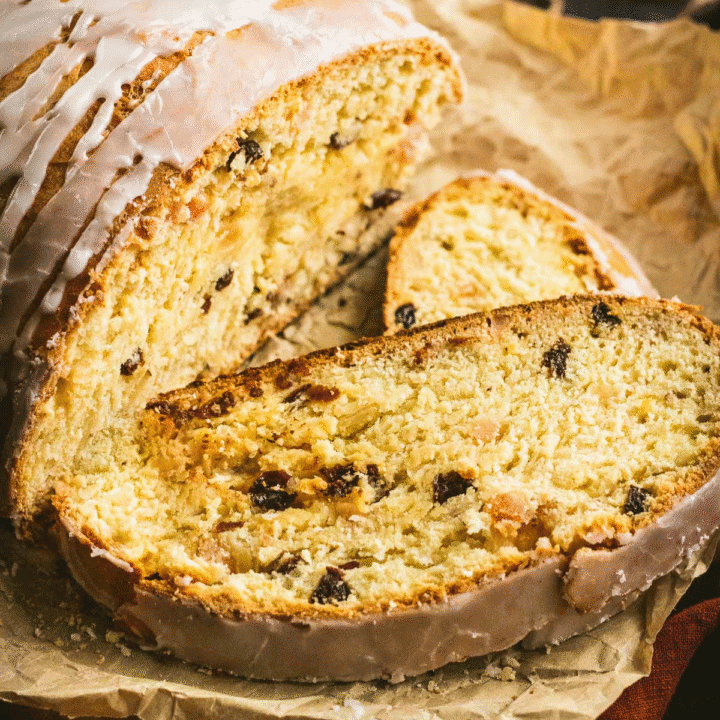This pillowy soft old-fashioned potato bread is baked in the Dutch oven to create a crispy, crunchy crust that makes this the perfect homemade loaf for toast & sandwiches. Made with just 5 simple ingredients, this will quickly become a beloved staple in your kitchen.

This website uses affiliate links which may earn commission for purchases made at no additional cost to you.
The Best Rustic Sandwich Loaf Ever
If you've never had German potato bread before, you're in for a treat! The inside is super soft and light, while the crust has a crispy texture. It's similar to my 3-ingredient Dutch oven white bread, but with an even chewier texture.
Now listen, I tested this recipe several times with different baking methods and ingredients. And in case you hadn't guessed it yet, the not-so-secret ingredient to this delicious loaf is mashed potatoes! I found that by salting the potatoes as they boil, you can get soooo much more flavor in the bread.
And I promise, it's totally not like eating your family's Thanksgiving mashed potatoes. This bread has a neutral (yet delicious) flavor that's great for all kinds of savory recipes like sandwiches and grilled cheese, or sweet treats like bread pudding and French toast.

Kartoffelbrot in Germany
Growing up in Germany, we'd sometimes get Kartoffelbrot from the local Bäckerei. It'd still be warm and fresh from their ovens. Then we'd either tear into it right away, or save it for dunking into a cozy soup for dinner.
I swear, this easy German potato bread is like a big hug in carb-form. And for more nostalgic German breads, try my pillowy soft sunflower seed bread or my chewy Dutch oven no-knead whole wheat bread.

Ingredients and Notes
- Russet potatoes - I prefer using russet potatoes since they have a lower moisture content than other potatoes, so they won't make your bread dough too wet or sticky. Russets also break down easily into creamy mashed potatoes, so there won't be big chunks of potato in your bread.
- Olive oil
- Bread flour - I like using bread flour (instead of all purpose) which creates a crisper crust and chewier texture inside.
- Salt - The measurement I included in this recipe is for table salt or fine sea salt, not kosher salt.
- Instant yeast - I prefer using instant yeast in this dough to make the rising and proofing times shorter. AKA more bread in my belly quicker!
Substitutions
- Flour - FYI Bread flour is also called baker's flour! And while you swap in all purpose flour, the texture and flavor will be slightly different.
- Potatoes - I've also tested this recipe with baker's potatoes, which work just as well as russet potatoes, as long as you peel them.
Welcome to My Kitchen! Let's Bake Potato Bread
Below is the process to make this recipe. For the full step-by-step directions and ingredient quantities, scroll down to the recipe card at the bottom of this post.

1. Peel and chop the potatoes.

2. Boil and mash with olive oil.

3. Whisk the bread flour, salt, and instant yeast together.

5. Mix in the rest of the flour mixture.

7. Set aside to rise in a warm spot.

9. Shape and proof the dough.

11. Place the dough in the hot Dutch oven and bake covered for 20 minutes.

4. Mix with ½ cup of cooking liquid and 1 cup of flour.

6. Knead the dough until it's smooth.

8. Rise the dough until it doubles in size.

10. Score the top of the dough.

12. Bake uncovered until the bread is golden and crispy on the outside.

Carissa's Potato Tip
To peel or not to peel? I tested it both ways and I personally prefer the smoother, consistent texture of bread with peeled potatoes. But feel free to leave that skin on for more flavor & less work!
Tips for a Tasty Old-Fashioned Loaf
- Don't Overmix: Don't over-mash your potatoes which can make them become gluey.
- Proof like a Pro: The dough is done proofing once it's puffed up slightly. It won't double in size, but when you stick your finger into the top, it should take a few seconds to fill the indent back to its original shape.
- Adjust the Texture: If your dough is too wet and sticky, add a little sprinkle of bread flour. If it's too dry after mixing and kneading it for a few minutes, add a teaspoon more of the reserved cooking liquid.
Storage
Make sure you let your loaf cool completely before storing. Then wrap it loosely in a paper bag or kitchen towel and store it at room temp in a cool, dry place.
Side note: I just got a bread box from IKEA and I am obsessed! It's like a little fancy condo for my homemade loaves!


Rustic German Potato Bread - Kartoffelbrot
Equipment
Ingredients
- 1 pound Russet potatoes (two medium)
- 1 Tablespoon olive oil
- ½ cup cooking liquid (from the boiled potatoes)
- 4 cups bread flour
- 1¾ teaspoons salt, divided (use either table salt or fine sea salt)
- 2¼ teaspoons instant yeast (one packet)
Instructions
- Peel the potatoes and cut them into 1-inch pieces. Place them in a large pot and cover with water along with one teaspoon of salt. Bring to a boil, and boil the potatoes until they're tender and easily pierced with a fork, after about 15 minutes.
- Reserve one cup of the cooking liquid from the pot and set aside to cool. Drain the rest of the liquid from the pot. Transfer the mashed potatoes to a large mixing bowl. Mash the potatoes and mix with the olive oil until smooth.
- In a separate mixing bowl, whisk to combine the bread flour, remaining ¾ teaspoon salt, and instant yeast.
- Add ½ cup of the reserved cooking liquid and about 1 cup of the flour mixture to the mashed potatoes. Mix until there's no dry flour visible and it resembles cookie dough. Add the remaining 3 cups of flour and mix again. The dough will be pretty dry at first, so I like to start kneading it and squeezing it in my hands in the mixing bowl to get the flour distributed.
- On a clean work surface, knead the dough for about 4 to 5 minutes by hand (or about 3 minutes in a stand mixer), until the dough is smooth and elastic. The more you knead it, the more the flour will absorb moisture and the dough will come together.If it's too wet or sticky, add a little more bread flour. If it's too dry, add a little more cooking liquid.
- Spread a little olive oil in the mixing bowl that had the flour mixture. Shape the dough into a ball and place it in the oiled bowl. Cover with a clean kitchen towel and set in a warm draft-free place to rise and double in size, after about 1 hour.
- On a lightly floured surface, shape the dough into a round or oval shape. Use your hands to gently push the sides of the dough underneath itself, to create tension on the top. Place the dough seam-side-up either in a proofing basket or in a shallow bowl lined with a kitchen towel. Cover the dough again with a towel and allow it to proof for 20 minutes while your oven preheats.
- Preheat the oven to 425°F. Place a Dutch oven with the lid in the oven to become hot as the oven preheats.
- Once the oven is preheated, carefully remove the Dutch oven from the oven and remove the lid. Place the dough onto a large piece of parchment paper seam-side-down. Score the top of the dough with a sharp kitchen knife with one long cut across the top about ¼ to ½ inch deep. Pick up the bread by holding the corners of the parchment paper, and carefully place it in the hot Dutch oven.
- Cover with the lid on and place it in the oven. Bake covered for 20 minutes, then remove the lid, and bake for an additional 15 to 20 minutes uncovered, until the crust is golden brown and crispy. Allow the loaf to cool on a cooling rack for at least 1 hour before slicing. Enjoy!!
Notes
- Peeling: I personally prefer the smoother, consistent texture of bread with peeled potatoes. But feel free to leave that skin on for more flavor & less work!
- Mashing: Don't over-mash your potatoes which can make them become gluey.
- Proofing: The dough is done proofing once it's puffed up slightly. It won't double in size, but when you stick your finger into the top, it should take a few seconds to fill the indent back to its original shape.
- Storing: Make sure you let your loaf cool completely before storing. Then wrap it loosely in a paper bag or kitchen towel and store it at room temp in a cool, dry place.
- Flour: FYI Bread flour is also called baker's flour. And while you substitute all purpose flour, the texture and flavor will be slightly different.
- Potatoes: I've also tested this recipe with baker's potatoes, which work just as well as russet potatoes, as long as you peel them.






Leonard Caponegro
It has been years since I have enjoyed German bread with my Mom and Omi. I am so happy I decided to start with the potato bread. It is like no other potato bread I have ever eaten. Dense yet airy, crusty with a crunch but not too crunchy. So delicious that my wife and son couldn't believe that there was potato in it. A definite keeper. Dankeschoen.
Shanon
This looks very pillowy! I like that it uses the dutch over which makes it much easier to bake in the over. Thank you!
sandy
when i get some potato's i will be trying the out, i have loved all your recipes you have shared so far thank you.
sandy,
Carissa Erzen
Hi Sandy, I'm so glad to hear that! Let me know how you like this bread.